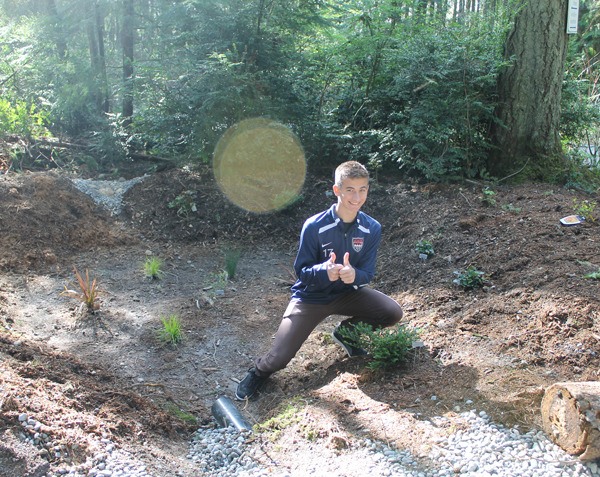Eighth-grader Connor McDanniel has crafted an end-of-year project to help mitigate the effects of storm water runoff in Maxwelton Creek.
McDanniel is a student of the Whidbey Island Waldorf School, which is located at the headwaters of the creek. All eighth graders are required to develop an end-of-year project with the help of a mentor.
McDanniel, who was interested in learning more about the environment and marine biology, thought that a rain garden would be a good way to decrease the impacts of brake dust and other runoff from the school’s parking lot and rooftop.
Nat Scholz, a researcher for the National Oceanic and Atmospheric Administration (NOAA) studying the impacts of storm water on juvenile and adult salmon, acted as McDanniel’s mentor and taught the student about water pollution.
Rob Hallbauer, a natural resource planner for the Whidbey Island Conservation District, helped design and install the garden.
Hallbauer has also designed several rain gardens for the City of Coupeville, and noted in an email to The Record that he thought McDanniel to be a “very bright kid.”
McDanniel said that his is one of the most common designs. Water is collected through a swale located by the playground which filters water from the parking lot and rooftop. The water then goes into the rain garden, which is separated into three zones featuring different types of plants.
Zone three contains plants which require the least amount of water; zone two plants require about an average amount of water; and zone one contains plants which can be fully submerged for up to a day at a time.
McDanniel noted that he isn’t sure he’ll have time to install more rain gardens in the near future, but the experience has inspired a rain garden business concept and a desire to learn more.
He began conceptualizing the garden about three weeks ago after doing extensive research which began in October.
The garden took about two to three weeks to design and two days to build.
“Pretty much all of the runoff from the school will be clean because of this thing. And, it will teach little guys about rain gardens because it is kind of an obscure thing,” said McDanniel. “It’s pretty important.”



